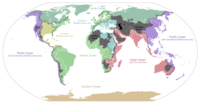
Photo from wikipedia
The Dongting Lake Basin and the Poyang Lake Basin, both located in the middle reaches of the Yangtze River, provide 30% of the total water volume for the Yangtze River.… Click to show full abstract
The Dongting Lake Basin and the Poyang Lake Basin, both located in the middle reaches of the Yangtze River, provide 30% of the total water volume for the Yangtze River. Under global climate change, precipitation patterns have undergone varying degrees of changes in different regions. Analysing temporal and spatial rainfall variations is important for understanding the variations in capacity of the two lake basins and the water intake variations by the Yangtze River. This study analyses the temporal and spatial variations of the two basins based on 33 rain-gauge data series from 1960–2015, using statistical methods, GIS spatial analysis and the M-K trend test. Our results showed that the annual precipitation generally increased in the Poyang Lake Basin and we found no obvious changes in the Dongting Lake Basin from 1960 to 2015. Seasonal precipitation levels at interannual scales were roughly consistent, but exhibited variability larger by an order of magnitude in the Poyang Lake Basin than in the Dongting Lake Basin. In general, an increasing trend dominated in spring and autumn while a decreasing trend was observed in summer and winter. The increasing trend was significant from the 1990s in the Poyang Lake Basin and from the late 1990s in the Dongting Lake Basin. It was found that annual precipitation with relatively larger anomalies appeared in ENSO (El Niño and Southern Oscillation) years in most cases, such as in 1963, 1997/1998 and 2002, while a few anomalies appeared in the previous or next year around an ENSO year, such as 1971 and 1978. All monthly precipitation periods with relatively larger or smaller anomalies coincided with ENSO events. In addition, El Niño and SOI (Southern Oscillation) events had significant relationships with negative monthly precipitation anomalies. El Niño and the SOI exerted more significant impacts on the Poyang Lake Basin than on the Dongting Lake Basin, which explains the conclusions regarding seasonal precipitation trends as mentioned above.
Journal Title: Scientific Reports
Year Published: 2020
Link to full text (if available)
Share on Social Media: Sign Up to like & get
recommendations!